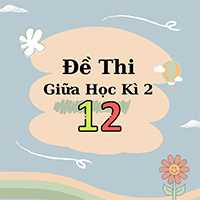Tiếng Anh 12 Global Success Unit 7 Project
Tiếng Anh 12 Unit 7 Project
Soạn tiếng Anh 12 Global success Unit 7 Project trang 99 hướng dẫn giải bài tập SGK tiếng Anh lớp 12 trang 99 giúp các em chuẩn bị bài tập SGK tiếng Anh hiệu quả.
THE PROS AND CONS OF MASS MEDIA
(Ưu điểm và nhược điểm của truyền thông đại chúng)
Work in groups. Give a presentation to compare two types of mass media you are interested in. Use these questions as cues for your presentation.
(Làm việc nhóm. Hãy thuyết trình để so sánh hai loại phương tiện truyền thông đại chúng mà bạn quan tâm. Sử dụng những câu hỏi này làm gợi ý cho bài thuyết trình của bạn.)
- What are the mass media types?
(Các loại phương tiện truyền thông đại chúng là gì?)
- How are they similar or different?
(Chúng giống và khác nhau như thế nào?)
- What are the advantages and disadvantages of each type?
(Ưu điểm và nhược điểm của từng loại là gì?)
- Which of them do you think will be more popular in the future? Why?
(Bạn nghĩ cái nào sẽ nổi tiếng hơn trong tương lai? Tại sao?)
Gợi ý
Presentation: Comparing Television and Social Media
1. What are the mass media types?
Television and Social Media are two major types of mass media.Television involves broadcasted programs, including news, shows, movies, and sports, typically consumed via a TV set.
Social Media refers to platforms like Facebook, Instagram, Twitter, TikTok, and YouTube where users can share content and engage with others online.
2. How are they similar or different?
Similarities:
Both are powerful tools for disseminating information to large audiences.
Both offer entertainment, news, and educational content.
Both have the ability to influence public opinion.
Differences:
Television is more structured, with scheduled programming and limited user interaction.
Social Media is on-demand, interactive, and user-driven, where anyone can post content and engage in real-time.
Television is passive, while social media is active and participatory.
3. Advantages and Disadvantages of Each Type
Television:
Advantages:
High-quality production, especially for news and entertainment.
Credibility, as content is produced by professional networks.
Broad audience reach, including older demographics.
Disadvantages:
Limited interaction with viewers.
Content is scheduled, which means less flexibility.
Expensive to produce and broadcast.
Social Media:
Advantages:
Instant access to content, anywhere, anytime.
Highly interactive and engaging.
Great for niche content and diverse audiences.
Low-cost for content creation (anyone can post).
Disadvantages:
Content quality can vary widely.
Spread of misinformation and lack of editorial control.
Overload of information, which can be overwhelming.
4. Which will be more popular in the future? Why?
Social Media is likely to be more popular in the future due to:
Growth of the internet and mobile usage: People are increasingly relying on smartphones and mobile data, making social media platforms more accessible.
User engagement: Social media allows individuals to create, comment, and share content instantly, providing a level of engagement that TV can't match.
Younger audience preference: Younger generations are more drawn to social media for its convenience, diversity of content, and interactive experience.
While TV will still be relevant, especially for live events like sports or news, social media's adaptability, user-generated content, and on-demand nature make it the more flexible and appealing platform for the future.
Both Television and Social Media have their strengths, but Social Media seems to be on the rise. It offers immediacy, user interaction, and the ability for anyone to participate, which aligns with the future's trends of personalization and connectivity. Television, while still influential, faces limitations in flexibility and interaction that social media overcomes.
Trên đây là Soạn tiếng Anh 12 Global Success Unit 7 Project đầy đủ nhất.










